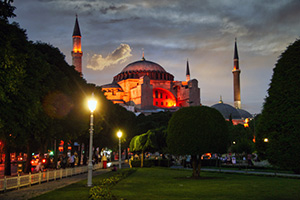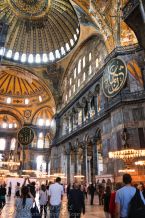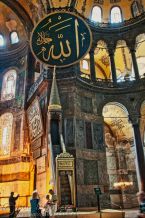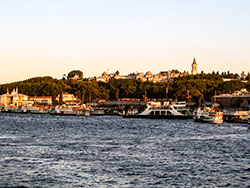The Basilica of the Holy Wisdom or Hagia Sophia (Aya Sofya in Turkish) is the major Byzantine building still standing in Istanbul. The central space of the edifice has an area of 7,000 square metres. The dome rises to 56.6 metres at its apex and has a diameter of 32.37 metres. It is one of the finest and most important architectural creations in the world.
Historical Background
The present church of Hagia Sophia is the third of that name to stand upon the site. The first church was dedicated on 15 February of 360, during the reign of Emperor Constantius II, but was destroyed by fire on 20 June 404, during a riot by mobs. Under the reign of Theodosius II, reconstruction began in the year 408. The second church of Hagia Sophia was completed and dedicated in 415. Unfortunately, it suffered the same fate as its predecessor, for it was burnt down during the Nika riots of 532. Emperor Justinian I immediately set out to rebuild the church on a greater scale than before, regardless of expense. Head architect was Anthelmus of Tralles (present Aydın) and his assistent Isidorus of Miletus, both distinguished scientists and mathematicians.
At its completion in 537, the edifice was considered to be the architectural wonder of its time. When its founder, Emperor Justinian I, first entered the immense church, he exclaimed "Glory to God that I have been judged worthy of such a work. Oh Solomon! I have outdone you!" At first the basilica was known as the Great Church because it was the largest at the time. Later it became known as Holy Wisdom, Hagia Sophia in Greek, a name attributed to Christ by theologians of the 4th century.
In May 558, damage by earthquakes caused the collapse of the eastern arch and semi-dome and the eastern part of the central dome. Justinian entrusted the restoration of the church to Isidorus the Younger, the nephew of Isidorus of Miletus. Isidorus made the dome somewhat higher than before, thereby lessening its outward thrust. This turned out to be a great success, since overall the dome survived until now, in spite of some partial collapses in the years 989 and 1346. Restorations of which have left some irregularities in the dome.
Despite the several restorations, the Hagia Sophia, as it is now, is essentially the same edifice as that of Justinian's reign. The only major additions are the huge, unappealing buttresses which support the building. These were added by command of Emperor Andronicus II Paleologos in 1317 to prevent the imminent danger of collapse of the church and were restored and strengthened in Ottoman times.
For almost a thousand years the Hagia Sophia, as Imperial Church of the Byzantine court, impressed the strength and wealth of the Byzantine emperors upon their subjects. In its heyday as Imperial Cathedral, Hagia Sophia was served by 80 priests, 150 deacons, 60 subdeacons, 160 readers, 25 cantors and 75 doorkeepers.
The worst desecration occurred in 1204, when the basilica was ransacked by the Latin soldiers during the Fourth Crusade and converted into a Catholic Church. Many of the sacred relics that were kept in the church were robbed and taken to the West. Baldwin of Flanders was crowned in the Hagia Sophia as Emperor of Rumania, as the Latins called the part of the Byzantine Empire that they had conquered. The leader of the gang was Dandolo, the Venetian Doge who persuaded the crusaders to attack Constantinople. Dandolo died the following year on 16 June 1205 and in the gallery of the Hagia Sophia where his tomb can still be seen, although tradition tells us that in 1453 his tomb was opened and his bones were thrown to the dogs. In 1261, after the Palaeologian renaissance, the Hagia Sophia returned to the control of the Orthodox Patriarch.
On Tuesday 29 May 1453, Sultan Mehmet the Conqueror, captured Constantinople, stopped the looting of the Hagia Sophia and took possession for Islam of the greatest religious edifice in the world. Four minarets were placed at various times after the conquest and the interior was adapted to the new religion. The Ottoman sultans refurbished and adorned the interior of the building in various ways. Noteworthy gifts are the large alabaster urns that were added by Sultan Murad III (1574-1595) and had been taken from Pergamon (present Bergama). In the 19th century the mosque was adorned with a set of large calligraphic medaillons bearing the names of God, Muhammed and the four caliphs which were the work of the famous calligrapher, Kazasker Mustafa İzzet Efendi.
For 470 years, the Haghia Sophia continued to function as a mosque until 1934 when Atatürk proclaimed it a museum. In 2020, it was by presidential decree turned again into a mosque.
Sights & Photos of Hagia Sophia
The Hagia Sophia is a huge impressive architectural marvel. The garden courtyard of the building contains the remains of its predecessor, the church of Theodosius. In the surroundings, there are also the tombs (Türbe) of five sultans, a token of the respect and reverence the Ottomans payed to the edifice. Another prominent Ottoman addition in the centre of the courtyard is the attractive rococo-style şadırvan, an ablution fountain, built by Sultan Mahmut I in about 1740.
https://www.turkeyphotoguide.com/hagia-sophia#sigProIdce8251f777
Entrance to the Hagia Sophia is through the "Beautiful Gates". The Byzantines were famous for their bronze doors, inlaid with gold and silver. Entering the church, it is hard not to be impressed by the grandor of the edifice.
https://www.turkeyphotoguide.com/hagia-sophia#sigProIdf5e874f37f
The few remaining mosaics of the Hagia Sophia are exquisite work of arts and a remnant of the glory and splendor of the Byzantines. Among them, especially the mosaic representing Christ between the Empress Zoe and the Emperor Constantine IX Monomachos and the one with the Virgin and Child flanked by Emperor Johannes Komnenos II and Empress Irene are of great beauty. When your visit is finished, don't forget to look back at the exit gate where another masterpiece of Byzantine art looks down on you, namely a mosaic in which Constantine the Great offers the City of Constantinople to Mary and Christ and Justinian I offers them the Hagia Sophia.
https://www.turkeyphotoguide.com/hagia-sophia#sigProId3b38f8cb8c























































